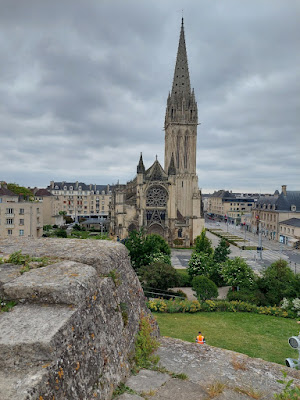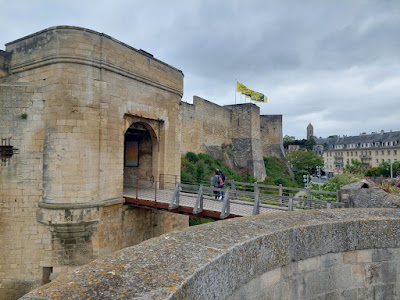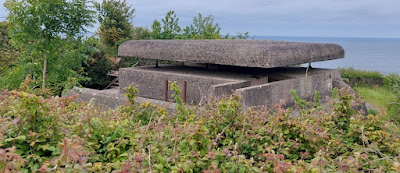Day 2 of the trip we visited Caen, Pegasus Bridge, Merville sur Mer and the Longues-sur-Mer Battery, then back to Bayeux for dinner.
Owyn wanted to see a castle and the one in Caen is in pretty good shape.
 |
| The castle from the parking garage. |
We made the twenty minute drive back to Caen from Bayeux and parked in the parking garage at the castle.
 |
| One of the many churches visible from the ramparts. This one is just across the street. |
 |
| An interesting medieval style house. I don't know how old it actually is. A lot of Caen was destroyed in WW II. |
 |
| The castle gatehouse as seen from the English barbican in front of it. |
 |
| The wall walk of the barbican. |
 |
| A look along the walls. You can see how difficult they would have been to storm. |
 |
| Looking back towards the gate house with the church steeple from earlier in the background. |
 |
| View from the top of the gatehouse. The English barbican is in front and the church behind it. |
 |
| Looking down on the barbican from a tower on the walls. |
There are several museums inside the castle as well as gardens and a cafe. The front part is in the best repair, with other bits being missing or in ruins.
 |
| A model of what the castle looked like in it's hey day. |
 |
| A palace and the back wall. |
 |
| The moat and a round tower. The castle is old enough that it has both square (old style) and round towers. |
 |
| The ruins of the inner Donjon or Keep. This is being excavated, though no work was being done while we were there. |
Once we'd seen what we wanted to at the castle we headed off to begin the WW II portion of our trip. Our first stop was
Pegasus Bridge. This was the site of a daring glider borne infantry attack by the British on a critical bridge, first thing on D-Day. Here's a
YouTube video if you want one. This event is also a major plot point in the movie The Longest Day.
There is an very nice museum at the site, as well as the current, reconstructed, version of the bridge for modern traffic and the original bridge behind the museum.
 |
In common with every museum we stopped at in Normandy, there were dioramas with gear and vehicles everywhere. They really show off the artifact well.
|
 |
| Lots of British weapons. |
 |
| This really shows just how much they crammed onto a tiny little jeep, and just why these vehicles were so critical to allied success in WW II. |
 |
| The original bridge, now placed behind the museum. |
 |
| British heavy artillery and a Cromwell tank. The markings on the turret are so that infantry can give the tank crew bearings to a target. |
 |
| The "new" bridge. Built to look just like the old one but able to withstand modern traffic. |
 |
| This German anti-tank gun was here on D-Day and used by the British glider troops to help hold the bridge after they'd taken it. |
 |
| The building in the top center of the picture was a maternity hospital on June 6th, 1944. The Germans fired on the bridge from there and the British fired back. |
 |
| The street to the museum is named after the British commanding officer, Maj. Howard. |
After the bridge we headed through the hedgerows and up to the coast. We skipped the British and Canadian beaches, in the interest of time, and stopped at Arromanches. This was the location of one of the Mulberry harbors, artificial harbors floated over from England to give the allies the ability to unload troops and supplies until they were able to capture a real harbor. As it happened most of these were destroyed in a large storm not long after they were installed.
The pieces of the harbor at Arromanches sur Mer are still visible and there's a path leading to the cliffs overlooking them that gives a great view of the remains, but also of the coast in both directions.
 |
| Pieces of the artificial harbor, resting where they were left by the storm of 1944. |
 |
| Looking down the cliff and towards the town. |
 |
| Owyn, posing with the town behind him. |
 |
| The cliffs are really quite impressive here. |
Our last stop for the day was the
Longues-sur-Mer Battery. This is a four gun battery that is still largely intact.
 |
| The most damaged of the bunkers, and Owyn reading (gasp) |
 |
| The plaque. Everything was in both French and English. |
 |
| This gun and bunker have been destroyed. |
 |
| A piece of the gun. |
 |
| The end of the barrel. |
 |
| The second bunker, gun intact. |
 |
| These were naval guns, designed for a cruiser, but put ashore to defend the Normandy coast. |
 |
| The rifling is still sharp even after 80 years in the weather. |
 |
| Poppies. The nature in this area was gorgeous. |
 |
| A mortar pit. Positioned to be able to drop mortar bombs both on the beaches below the battery but also on the land side approaches. |
 |
| Only the tip of the barrel would have showed above the concrete. |
 |
One of the guns. The base is full of water.
|
 |
| The observation bunker for the battery. You can see how great a view it would have had of the fleet offshore on June 6th. |
 |
| The fields around the battery. This grass is silvery and was blowing in the wind. It was mesmerizing. |
Once finished at the battery we headed back to Bayeux and our dinner. We ate at the restaurant right next to last night's place and had another fantastic meal.
 |
I got the mussels and fries. They were cooked in a cream sauce.
|
 |
| Owyn tried the beef bourguignon. It was great. He also helped me with my moules since my appetite was definitely not what it usually is. |
 |
| Dad got the fish and also loved that. |
We finished with our new favorite Normandy desert,
Trou Normand. It's apple sorbet on top of
Calvados (apple brandy). It's a true delicacy.
Following dinner we walked a little bit farther down the main street than we had before and found this picturesque area.
 |
| The Bayeux tapestry museum is in that direction. |
 |
| This spot, with the water wheel is the done thing for influencers in Bayeux. Happily we did not see any such creatures. |
After that we walked back to the house and went to sleep.













































No comments:
Post a Comment